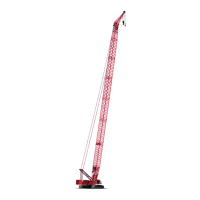INTRODUCTION 16000 SERVICE/MAINTENANCE MANUAL
1-36
Published 05-09-17, Control # 014-28
LOAD DRUM 2
System Components
See Figure 1-26, Figure 1-27, and Figure 1-28 for the
following procedure.
Load drum 2 is located at the front top of rotating bed. One
hydraulic pump drives one motor gearbox on right side end
of drum (standard) or drives two separate motor gearboxes
on each end of drum 2 (optional). Load drum 1 pump is
dedicated to operate with load drum 2 though a diverting
valve. Hydraulic connections between the pump and motors
form a closed-loop system that is controlled with control
handle movement and node controllers. The center load
drum control handle on the right side console operates drum
2. The control handle is inoperable when drum 2 park brake
is applied.
Hydraulic charge pressure from system charge pump
supplies hydraulic make-up fluid to low-pressure side of
each drum 2 motor. A pressure sender in high-pressure side
of pump leg provides system pressure information to Node-1
controller. Low-side pressure supplies hydraulic pilot
pressure to operate motor servos. A fixed orifice between
pump ports A and B allows for smoother drum operation.
When load drum 2 motors rotate, a speed sensor at one
motor rotor monitors and sends an input voltage to Node-1
controller. Node-2 controller sends an output voltage to
rotation indicator in control handle. As drum rotates faster,
the rotation indicator on top of control handle pulsates with a
varying frequency that indicates drum rotational speed. The
handle command in percent from neutral is shown on
Diagnostic Screen.
Continuous changing of closed-loop fluid occurs with
leakage in pump, motor, and external sequence/flow valve.
Sequence/flow valve opens at 200 psi (14 bar) and removes
4 gallons per minute (15 l/m) of hot fluid from system by
discharging exhausted fluid into motor case where the fluid
returns to tank.
Load Drum 2 Brake
Hydraulic pressure to operate drum 2 brake is from low-
pressure side of system.
When drum 2 brake switch is in on - park position, drum
brake release solenoid HS-20 is disabled so brakes are
applied to each side of drum shaft. Drum pump does not
stroke in response to control handle movement.
When drum 2 brake switch is placed in off - park position,
brake release solenoid HS-20 remains applied. Brakes
remain applied until Node-5 controller sends a 24 volt output
to release the brake. The drum circuit is active, waiting for a
control handle command.
Raising Load
See Figure 1-26 and Figure 1-28 for the following procedure.
When drum 2 control handle is moved back for raising, an
input voltage of 2.4 volts or less is sent to Node-1 controller.
Node-3 controller sends a variable zero to 24 volt output that
is divided by a resistor and applied to pump 6 EDC in the
raising direction. Node-4 controller sends a 24 volt output to
enable drum 1 to drum 2 diverting solenoid HS-16. Node-3
controller sends a variable zero to 24 volt output that is
divided by a resistor and applied to pump 4 EDC in the
raising direction. Both pumps supply hydraulic fluid to drum
2 motors. Node-3 and 5 controllers send a variable zero to
24 volt output that is divided by a resistor and applied to both
motor PCP’s. Node-1 controller checks that drum block-up
limit switches are closed and no system faults are present.
Pump EDC tilts swashplate in the raising direction to satisfy
pressure memory. Node-1 controller compares drum holding
pressure to value in pressure memory. When system
pressure is high enough, Node-5 controller sends a 24 volt
output to enable drum 2 brake release solenoid HS-20. Drum
brake solenoid shifts to block drain port and opens port to
low-pressure side of drum system to release brake from
drum shaft.
Each pump EDC tilts swashplate in the raising direction as
hydraulic fluid flow is from pump ports to motor ports. Return
fluid is from motor outlet ports to pump inlet ports.
Node-3 controller output voltages to each pump EDC and
Node-3 and 5 controllers output voltage to each motor PCP
is relative to control handle movement. As control handle is
moved back, an output voltage increases the pumps
swashplate angles.
NOTE: If drum 1 is selected to operated at the same time,
Node-4 controller sends a 24 volt output to disable
drum 1 to drum 2 diverting solenoid HS-16. Drum 2
speed is reduced up to one half.
FIGURE 1-26
HS-20
HS-16
HS-21
Brake
Diverting
Valve
Motors
(PCP)
Pump
(EDC)
Pressure
Sender
Pump
(EDC)
16-1018
Accessory Pump
(Low-Pressure)
Accessory
Pump (Low-
Pressure)

